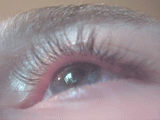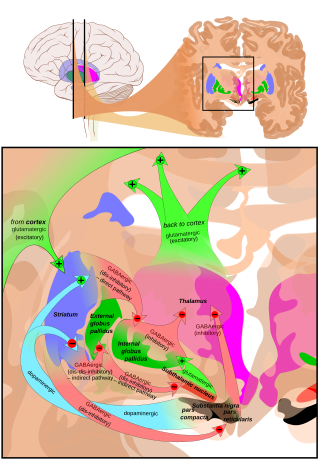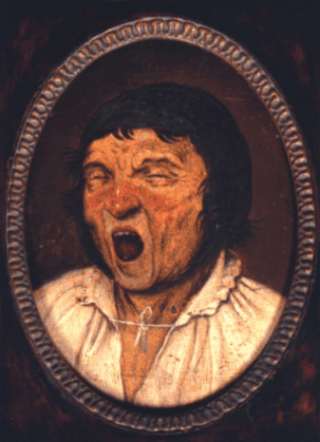Related Research Articles

A tremor is an involuntary, somewhat rhythmic, muscle contraction and relaxation involving oscillations or twitching movements of one or more body parts. It is the most common of all involuntary movements and can affect the hands, arms, eyes, face, head, vocal folds, trunk, and legs. Most tremors occur in the hands. In some people, a tremor is a symptom of another neurological disorder.

Benign fasciculation syndrome (BFS) is characterized by fasciculation (twitching) of voluntary muscles in the body. The twitching can occur in any voluntary muscle group but is most common in the eyelids, arms, hands, fingers, legs, and feet. The tongue can also be affected. The twitching may be occasional to continuous. BFS must be distinguished from other conditions that include muscle twitches.
A hypnic jerk, hypnagogic jerk, sleep start, sleep twitch, myoclonic jerk, or night start is a brief and sudden involuntary contraction of the muscles of the body which occurs when a person is beginning to fall asleep, often causing the person to jump and awaken suddenly for a moment. Hypnic jerks are one form of involuntary muscle twitches called myoclonus.

A cramp is a sudden, involuntary, painful skeletal muscle contraction or overshortening associated with electrical activity; while generally temporary and non-damaging, they can cause significant pain and a paralysis-like immobility of the affected muscle. A cramp usually goes away on its own over a period of several seconds or (sometimes) minutes. Cramps are common and tend to occur at rest, usually at night. They are also often associated with pregnancy, physical exercise or overexertion, age, in such cases, cramps are called idiopathic, because there is no underlying pathology. In addition to those benign conditions cramps are also associated with many pathological conditions.

A tic is a sudden and repetitive motor movement or vocalization that is not rhythmic and involves discrete muscle groups. It is typically brief, and may resemble a normal behavioral characteristic or gesture.
Exploding head syndrome (EHS) is an abnormal sensory perception during sleep in which a person experiences auditory hallucinations that are loud and of short duration when falling asleep or waking up. The noise may be frightening, typically occurs only occasionally, and is not a serious health concern. People may also experience a flash of light. Pain is typically absent.

Myoclonus is a brief, involuntary, irregular twitching of a muscle, a joint, or a group of muscles, different from clonus, which is rhythmic or regular. Myoclonus describes a medical sign and, generally, is not a diagnosis of a disease. It belongs to the hyperkinetic movement disorders, among tremor and chorea for example. These myoclonic twitches, jerks, or seizures are usually caused by sudden muscle contractions or brief lapses of contraction. The most common circumstance under which they occur is while falling asleep. Myoclonic jerks occur in healthy people and are experienced occasionally by everyone. However, when they appear with more persistence and become more widespread they can be a sign of various neurological disorders. Hiccups are a kind of myoclonic jerk specifically affecting the diaphragm. When a spasm is caused by another person it is known as a provoked spasm. Shuddering attacks in babies fall in this category.

An eyelid is a thin fold of skin that covers and protects an eye. The levator palpebrae superioris muscle retracts the eyelid, exposing the cornea to the outside, giving vision. This can be either voluntarily or involuntarily. "Palpebral" means relating to the eyelids. Its key function is to regularly spread the tears and other secretions on the eye surface to keep it moist, since the cornea must be continuously moist. They keep the eyes from drying out when asleep. Moreover, the blink reflex protects the eye from foreign bodies. A set of specialized hairs known as lashes grow from the upper and lower eyelid margins to further protect the eye from dust and debris.

Hyperkinesia refers to an increase in muscular activity that can result in excessive abnormal movements, excessive normal movements, or a combination of both. Hyperkinesia is a state of excessive restlessness which is featured in a large variety of disorders that affect the ability to control motor movement, such as Huntington's disease. It is the opposite of hypokinesia, which refers to decreased bodily movement, as commonly manifested in Parkinson's disease.

A fasciculation, or muscle twitch, is a spontaneous, involuntary muscle contraction and relaxation, involving fine muscle fibers. They are common, with as many as 70% of people experiencing them. They can be benign, or associated with more serious conditions. When no cause or pathology is identified, they are diagnosed as benign fasciculation syndrome.
Hemifacial spasm (HFS) is a rare neuromuscular disease characterized by irregular, involuntary muscle contractions (spasms) on one side (hemi-) of the face (-facial). The facial muscles are controlled by the facial nerve, which originates at the brainstem and exits the skull below the ear where it separates into five main branches.

Ophthalmoparesis refers to weakness (-paresis) or paralysis (-plegia) of one or more extraocular muscles which are responsible for eye movements. It is a physical finding in certain neurologic, ophthalmologic, and endocrine disease.

Blepharospasm is any abnormal contraction of the orbicularis oculi muscle. The condition should be distinguished from the more common, and milder, involuntary quivering of an eyelid, known as myokymia, or fasciculation. In most cases, blepharospasm symptoms last for a few days and then disappear without treatment, but in some cases the twitching is chronic and persistent, causing life-long challenges. In these cases, the symptoms are often severe enough to result in functional blindness. The person's eyelids feel like they are clamping shut and will not open without great effort. People have normal eyes, but for periods of time are effectively blind due to their inability to open their eyelids. In contrast, the reflex blepharospasm is due to any pain in and around the eye.

Meige's syndrome is a type of dystonia. It is also known as Brueghel's syndrome and oral facial dystonia. It is actually a combination of two forms of dystonia, blepharospasm and oromandibular dystonia (OMD).
Intention tremor is a dyskinetic disorder characterized by a broad, coarse, and low-frequency tremor evident during deliberate and visually-guided movement. An intention tremor is usually perpendicular to the direction of movement. When experiencing an intention tremor, one often overshoots or undershoots one's target, a condition known as dysmetria. Intention tremor is the result of dysfunction of the cerebellum, particularly on the same side as the tremor in the lateral zone, which controls visually guided movements. Depending on the location of cerebellar damage, these tremors can be either unilateral or bilateral.

Foix–Chavany–Marie syndrome (FCMS), also known as bilateral opercular syndrome, is a neuropathological disorder characterized by paralysis of the facial, tongue, pharynx, and masticatory muscles of the mouth that aid in chewing. The disorder is primarily caused by thrombotic and embolic strokes, which cause a deficiency of oxygen in the brain. As a result, bilateral lesions may form in the junctions between the frontal lobe and temporal lobe, the parietal lobe and cortical lobe, or the subcortical region of the brain. FCMS may also arise from defects existing at birth that may be inherited or nonhereditary. Symptoms of FCMS can be present in a person of any age and it is diagnosed using automatic-voluntary dissociation assessment, psycholinguistic testing, neuropsychological testing, and brain scanning. Treatment for FCMS depends on the onset, as well as on the severity of symptoms, and it involves a multidisciplinary approach.

Ptosis, also known as blepharoptosis, is a drooping or falling of the upper eyelid. This condition is sometimes called "lazy eye", but that term normally refers to the condition amblyopia. If severe enough and left untreated, the drooping eyelid can cause other conditions, such as amblyopia or astigmatism, so it is especially important to treat the disorder in children before it can interfere with vision development.

Periorbital puffiness, also known as puffy eyes, or swelling around the eyes, is the appearance of swelling in the tissues around the eyes, called the orbits. It is almost exclusively caused by fluid buildup around the eyes, or periorbital edema. Minor puffiness usually detectable below the eyes only is often called eye bags. Such transient puffiness is distinct from the age related and gradual increase in the size of the fat pad lying below the lower eyelids which can also be colloquially referred to as eye bags.
Synkinesis is a neurological symptom in which a voluntary muscle movement causes the simultaneous involuntary contraction of other muscles. An example might be smiling inducing an involuntary contraction of the eye muscles, causing a person to squint when smiling. Facial and extraocular muscles are affected most often; in rare cases, a person's hands might perform mirror movements.
The paroxysmal dyskinesias (PD) are a group of movement disorders characterized by attacks of hyperkinesia with intact consciousness. Paroxysmal dyskinesia is a rare disorder, however the number of individuals it affects remains unclear. There are three different subtypes of PD that include paroxysmal kinesigenic dyskinesia (PKD), paroxysmal nonkinesigenic dyskinesia (PNKD), and paroxysmal exercise-induced dyskinesia (PED). Other neurological diseases have similar symptoms to PD, such as epilepsy and Parkinson's. The different subtypes make accurate and quick diagnosis of PD challenging. Thus, PD is often under reported and misdiagnosed, making it difficult to accurately study its prevalence in human populations. Onset of PD is usually in late childhood to early adolescence. New drug regimens help treat symptoms of PD, but no cure for the disorder is known.
References
- ↑ Walton, C.; Kalmar, J. M; Cafarelli, E (18 October 2002). "Effect of caffeine on self-sustained firing in human motor units". The Journal of Physiology. 545 (2): 671–679. doi:10.1113/jphysiol.2002.025064. PMC 2290683 . PMID 12456842.
- 1 2 3 Ha, Ainhi D.; Jankovic, Joseph (2011-01-01), Brotchie, Jonathan; Bezard, Erwan; Jenner, Peter (eds.), "An Introduction to Dyskinesia—The Clinical Spectrum", International Review of Neurobiology, Pathophysiology, Pharmacology, and Biochemistry of Dyskinesia, 98, Academic Press: 1–29, doi:10.1016/b978-0-12-381328-2.00001-8, ISBN 9780123813282, PMID 21907081 , retrieved 2020-11-13
- ↑ "EyeTwitching.net Myokymia Causes". 2010. Archived from the original on 2013-09-07. Retrieved 2010-10-22.
- ↑ Facta 2001, part 4, page 113, finnish